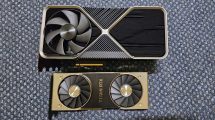Hybrid hardware solution: 300 watt limit via the adapter (450 watts) and the software
Now I’m going to mix the two. On the one hand, I run the card as a 450-watt model and on the other, I reduce the power limit to 300 watts. A counter-test with a KFA2 RTX 4090 SG 1-Clock OC resulted in the same values! So you first take the hard cut and then slow it down using software. Since you can only specify whole percentages in the Afterburner, I ended up around 1.5 watts above that, but you can take that into account later.
Let’s first take a look at the power consumption and performance, which at 38.1 FPS now drops by around 14 percentage points. The card requires around 315 watts for this, so it is only around 13.5 watts above the preset limit. What is noticeable, however, is the significantly less smooth running of the power consumption, where the load peaks can rise to almost 552 watts!

The corresponding currents look just as jittery and average only around 23.5 amps on the 12-volt rails. However, the peaks reach almost 40 amps again, which seems quite a lot in my opinion. So we can look forward to the software-only solution.
Software solution: 300 watts as default with the MSI Afterburner
Now we are right back to the point with the limits, but we will immediately notice that the system is now a little more reluctant, but also cuts better.
The card consumes 326.9 watts for 38.41 FPS, but offers the better variances. The course of the power consumption and transients also looks much more pleasant, as it is not even 499 watts at the peak.
This can also be seen in the currents, which are fixed at a maximum of 32 amps. In fact, the average is only 22.5 amps, which is slightly less than in the hybrid test. The fact that the power consumption is nevertheless higher is due to the operating voltage, which is slightly higher on average due to the different load distribution. Mind you, if I do all this on the laboratory power supply, these differences are almost completely eliminated. However, the secondary-side regulation of PC power supplies is somewhat more susceptible to such strongly and rapidly fluctuating loads. I have also done this with a real single-rail power supply from Corsair – the result is the same as with the be quiet! power supply except for a difference of 1-2 watts.








































180 Antworten
Kommentar
Lade neue Kommentare
Urgestein
Veteran
1
Urgestein
Urgestein
Urgestein
Neuling
Urgestein
Mitglied
Veteran
Mitglied
Urgestein
Urgestein
1
1
Urgestein
Urgestein
Urgestein
Urgestein
Alle Kommentare lesen unter igor´sLAB Community →